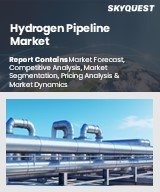
세계의 수소 파이프라인 시장 규모는 2023년에 94억 달러에 달하며, 2024년 109억 달러에서 2032년에는 363억 달러로 성장할 것으로 예측되며, 예측 기간(2025-2032년)의 CAGR은 16.2%로 성장하고 있습니다.
세계 수소 파이프라인 시장은 저탄소 에너지 네트워크 개발에 대한 정부 및 산업계의 노력에 힘입어 크게 성장하고 있습니다. 이러한 모멘텀은 파이프라인 프로젝트를 가속화하고 이해관계자간 협력을 촉진하기 위한 정책 프레임워크 강화 및 자금 조달 구상로 이어지고 있습니다. 혁신적인 발전에는 지속가능한 공급망을 보장하고 운송 비용을 절감하기 위한 국경 간 파이프라인 계획이 포함됩니다. 또한 주요 에너지 기업은 기존 천연가스 인프라를 수소 혼합을 촉진하기 위해 기존 천연가스 인프라를 개조하여 에너지 시스템의 전략적 진화를 보여주고자 합니다. 주목할 만한 동향은 파이프라인의 무결성을 향상시키는 첨단 모니터링 기술과 재료의 통합이며, 센서 기반 솔루션과 예측 분석을 통해 사전 예방적 유지보수를 가능케 하는 것입니다. 이러한 개발은 복합강합금 사용과 함께 장거리 수소 운송의 신뢰성을 높이고 있습니다.
Global Hydrogen Pipeline Market Size was valued at USD 9.4 Billion in 2023 poised to grow from USD 10.9 Billion in 2024 to USD 36.3 Billion by 2032, growing at a CAGR of 16.2% in the forecast period (2025-2032).
The global hydrogen pipeline market is experiencing significant growth, fueled by increasing governmental and industrial commitments to develop low-carbon energy networks. This momentum has led to enhanced policy frameworks and funding initiatives aimed at expediting pipeline projects and fostering collaboration among stakeholders. Innovative advancements include plans for cross-border pipelines to secure sustainable supply chains and reduce transportation costs. Additionally, leading energy companies are adapting existing natural gas infrastructure to facilitate hydrogen blends, showcasing a strategic evolution in energy systems. A notable trend is the integration of advanced monitoring technologies and materials that improve pipeline integrity, enabling proactive maintenance through sensor-based solutions and predictive analytics. These developments, alongside the use of composite steel alloys, enhance reliability for long-distance hydrogen transport.
Top-down and bottom-up approaches were used to estimate and validate the size of the Global Hydrogen Pipeline market and to estimate the size of various other dependent submarkets. The research methodology used to estimate the market size includes the following details: The key players in the market were identified through secondary research, and their market shares in the respective regions were determined through primary and secondary research. This entire procedure includes the study of the annual and financial reports of the top market players and extensive interviews for key insights from industry leaders such as CEOs, VPs, directors, and marketing executives. All percentage shares split, and breakdowns were determined using secondary sources and verified through Primary sources. All possible parameters that affect the markets covered in this research study have been accounted for, viewed in extensive detail, verified through primary research, and analyzed to get the final quantitative and qualitative data.
Global Hydrogen Pipeline Market Segments Analysis
The global hydrogen pipeline market is segmented based on type, status, length, and region. In terms of type, the market is divided into offshore and onshore. Based on status, the market is bifurcated into new and repurposed. Based on length, the market is grouped into up to 300km and more than 300 km. Based on region, the market is segmented into North America, Europe, Asia-Pacific, Central & South America and the Middle East & Africa.
Driver of the Global Hydrogen Pipeline Market
The expansion of the global hydrogen pipeline market is significantly influenced by supportive policies from various governments, which serve as a crucial driver of growth. National hydrogen strategies are being implemented by numerous economies, providing funding incentives and simplifying regulatory frameworks to attract private investments. These government initiatives help mitigate financial risks for businesses while promoting standardization across different agencies, facilitating the execution of large-scale projects. Furthermore, subsidies for pipeline construction, tax breaks, and the establishment of dedicated hydrogen corridor plans are effectively transforming ambitious policies into tangible infrastructure development, paving the way for a robust hydrogen economy worldwide.
Restraints in the Global Hydrogen Pipeline Market
A significant challenge in the advancement of hydrogen pipelines is the risk of material degradation caused by hydrogen embrittlement. This phenomenon can lead to the formation of cracks in standard steel pipelines due to prolonged hydrogen exposure, raising concerns regarding safety and structural integrity. To mitigate these issues, alternatives like specialized alloys or internal linings must be employed; however, these solutions can substantially elevate construction and retrofitting expenses. Such technical difficulties may prolong the project approval process, necessitating continuous research and development efforts to address these concerns effectively and ensure the long-term viability of hydrogen infrastructure.
Market Trends of the Global Hydrogen Pipeline Market
The Global Hydrogen Pipeline market is witnessing a significant trend towards integrating digital twin technologies in pipeline operations. As operators increasingly leverage these advanced platforms, they enhance real-time simulation, monitoring, and optimization of pipeline performance. This innovative approach allows for accurate forecasting of material fatigue, pressure variations, and improved failure response strategies, leading to maximized uptime and prolonged asset life. With the anticipated surge in hydrogen volumes transported through both repurposed and new infrastructure, digital twin technologies provide a scalable solution to ensure system integrity and operational efficiency, positioning them as a vital component in the future of hydrogen distribution networks.